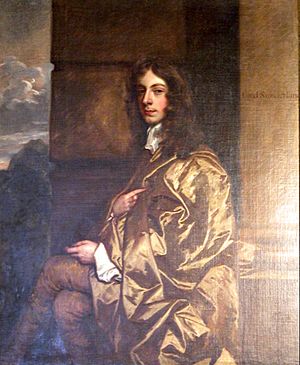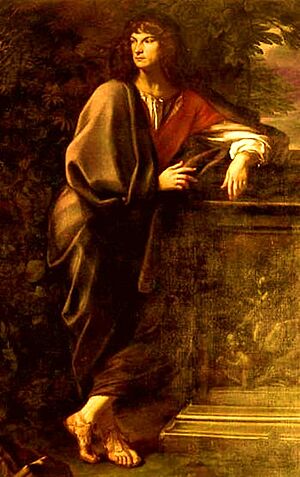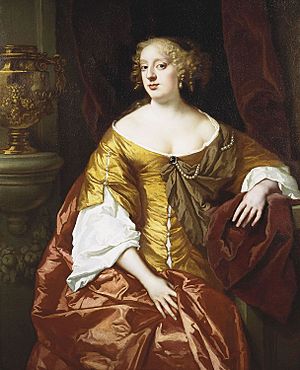Robert Spencer, 2nd Earl of Sunderland facts for kids
Quick facts for kids
The Earl of Sunderland
|
|
|---|---|

Robert Spencer, Second Earl of Sunderland
|
|
| Lord Lieutenant of Warwickshire | |
| In office 4 December 1687 – 20 June 1689 |
|
| Lord President of the Council | |
| In office 4 December 1685 – October 1688 |
|
| Monarch | James II |
| Preceded by | Marquess of Halifax |
| Succeeded by | Marquess of Carmarthen |
| Lord Lieutenant of Staffordshire | |
| In office 12 December 1679 – 2 September 1681 |
|
| Secretary of State for the Northern Department | |
| In office 10 February 1679 – 26 April 1680 |
|
| Monarch | Charles II |
| Preceded by | Sir Joseph Williamson |
| Succeeded by | Sir Leoline Jenkins |
| Personal details | |
| Born |
Robert Spencer
5 September 1641 Paris, Kingdom of France |
| Died | 28 September 1702 (aged 61) Althorp, Northamptonshire |
| Resting place | Brington, Northamptonshire |
| Spouse | |
| Parents | Henry Spencer, 1st Earl of Sunderland Dorothy Sidney |
| Alma mater | Christ Church, Oxford |
| Occupation | Politician |
Robert Spencer, 2nd Earl of Sunderland (born 5 September 1641, died 28 September 1702) was an important English nobleman and politician. He belonged to the famous Spencer family. Robert Spencer was a very skilled statesman. He was known for his strong opinions and his belief in absolute monarchy, where a king or queen has total power. This sometimes made him unpopular.
In 1688, he had to leave England. But after the Glorious Revolution that same year, he managed to work with the new government. Later, he became an adviser to the King, not seeking special jobs or favors for himself. He was loyal to his country's interests, even if it meant changing his political views. Unlike many at the time, his personal life was quite private and free from scandal. This helped him gain trust in the new government after the Revolution.
Contents
Robert Spencer: A Key Figure in English History
Early Life and Beginnings
Robert Spencer was born in Paris in 1641. His father, Henry Spencer, 1st Earl of Sunderland, died in battle when Robert was only three years old. His mother was Lady Dorothy Sidney. When his father died, Robert inherited his titles, becoming the Baron of Wormleighton and Earl of Sunderland.
His mother made sure he received a good education. He first had a private teacher and then attended Christ Church, Oxford university. After school, he joined the English Army and became a captain.
On 10 June 1665, he married Lady Anne Digby. She was the daughter of the 2nd Earl of Bristol. Lady Anne lived until 1715.
Sunderland then worked as an ambassador for England. He served in Madrid (1671–1672), Paris (1662–1673), and the United Provinces (1673). From 1673 to 1679, he was a Gentleman of the Bedchamber, a close attendant to the King. In 1679, he became a Privy Councillor and was appointed Secretary of State for the Northern Department. This meant he was a key government official.
People quickly noticed his political skills. Even those who didn't like him praised his ability to understand and handle important matters quickly. Some people thought he only wanted high-paying jobs because he spent a lot of money. He enjoyed collecting art and made changes to his home, Althorp.
Serving Kings Charles II and James II
Robert Spencer's main goal was to make England stronger in Europe. He wanted to build alliances with other countries to balance the power of France. From 1679 to 1681, he tried to create an alliance against France. He succeeded in making a treaty with Spain in 1680, but not much else came from his efforts.
Sunderland had a difficult relationship with Paul Barillon, the French Ambassador. Sunderland once told Barillon that if he acted badly, it was only fair that he faced the consequences.
Sunderland also served as Lord Lieutenant of Staffordshire until 1681. That year, King Charles II removed him from office. This was because Sunderland did not support the Duke of York (who later became King James II) becoming the next king.
However, Sunderland soon regained the King's trust. Between 1682 and 1688, he held several important positions. These included Secretary of State for the Southern Department, Lord Lieutenant of Warwickshire, and Lord President of the Council. In 1687, he signed a document that granted religious freedom for French Protestants settling in Virginia. This was done to encourage more people to move there.
Challenges and Changes
In 1687, Sunderland officially became a Roman Catholic. Many believed he did this simply to please King James II, who was Catholic. Later that year, he was made a Knight of the Garter, a very high honor.
Even though Queen Mary of Modena trusted him, Sunderland became uncomfortable under King James II. He was very unpopular with the public. When he spoke at the trial of the Seven Bishops, the crowd reacted very negatively. King James eventually dismissed him in October 1688. The King told him, "I hope you will be more faithful to your next master than you have been to me."
Working with King William III
After being dismissed, Sunderland escaped to Rotterdam in the Netherlands. He stayed hidden for a while before being briefly arrested and then released by Dutch officials. He then offered his help to the Prince of Orange (who would become King William III). Sunderland remained quiet in Utrecht during the Glorious Revolution in England, when William III and Mary II took the throne.
After William and Mary became King and Queen, Sunderland asked a prominent statesman, Sir John Churchill, to help him. Sunderland was known for being rude, but he also had a surprising ability to make lasting friends. Some of his friends, like John Evelyn and Thomas Tenison, had influence with the new government. His sister, Dorothy, was married to George Savile, 1st Marquess of Halifax, a key adviser to William III. Halifax felt he should help Sunderland because they were family.
At first, King William III did not include Sunderland in a special act that pardoned people for past actions. However, Sunderland was allowed to return to England early the next year.
When he returned, Sunderland officially became an Anglican again. In May 1691, King William visited him at his home in Althorp, Northamptonshire, to discuss important matters. Over the next few years, the King often visited Sunderland and trusted him. Sunderland did not fully return to public life until September 1693.
He often advised the King to choose all his ministers from one political party. He also helped King William and his sister-in-law, Princess Anne (who later became Queen Anne), become friends again. Sunderland was an important adviser, convincing William to choose only Whigs for his government. King William was not bothered by Sunderland's past service to King James. William valued Sunderland for his honesty and his ability to speak difficult truths. It is thought that Sunderland's directness appealed to the King, who disliked flattery.
Later Years and Retirement
Sunderland's direct way of speaking made him many enemies. People thought he was too quick to criticize others. His ability to adapt to three different monarchs was seen as a flaw by some. They believed he was not always trustworthy.
In 1697–98, Sunderland faced a difficult situation involving his daughter, Elizabeth. Her husband, Lord Clancarty, who supported the old King James, escaped from the Tower of London. The marriage had been arranged when Elizabeth was young. Lord Clancarty found Elizabeth and they reunited. Her brother, Charles, had Clancarty arrested. This caused a lot of embarrassment for Sunderland. However, King William seemed amused and allowed the couple to move to Germany. Elizabeth lived there and never saw her parents or brother again.
Sunderland became Lord Chamberlain of the Household in April 1697. He also served as a Lord Justice for a short time. However, he felt that people still suspected him. He was also getting older and his health was not good. He decided to retire from public life in December 1697.
Robert Spencer died in 1702. He had been living a quiet life at Althorp. His only surviving son, Charles, inherited his titles.
Family Life
Robert Spencer married Anne Digby on 9 June 1665. Their marriage was a happy one. Robert Spencer was a devoted husband and father. They had at least five children:
- Robert Spencer (1666–1688)
- Anne Spencer (1667–1690), who married James Douglas, 4th Duke of Hamilton.
- Isabella Spencer (1668–1684)
- Elizabeth Spencer (1671–1704), who married Donough MacCarthy, 4th Earl of Clancarty.
- Charles Spencer (c. 1674–1722), who became the 3rd Earl of Sunderland.
They are believed to have had two or more other children who died when they were very young.
See also



